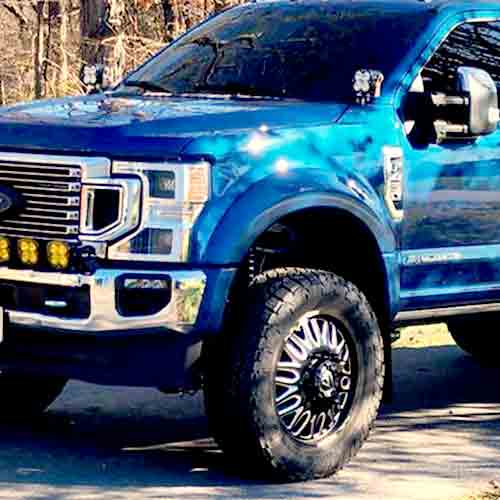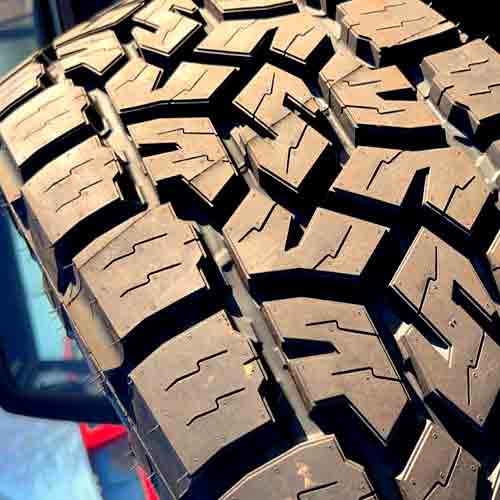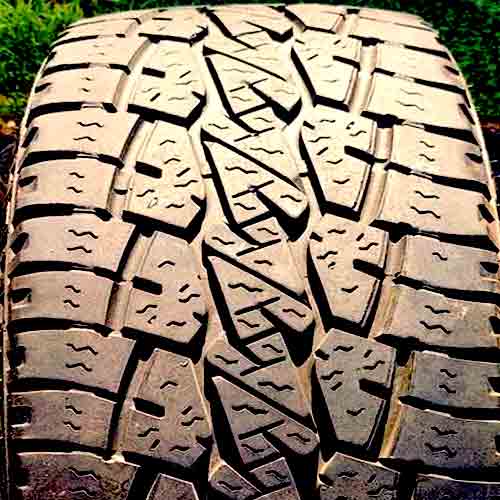The Toyo Open Country AT3 and the Pro Comp AT Sport are two aggressive all-terrain tires that both caught my eye with their promising tread designs. But which one comes out on top when it comes to on-road manners, and which one excels off-road? Let’s find out!

In my professional opinion as a tire engineer, the Pro Comp AT Sport with its closed up design provide superior dry grip, and steering response. It also provides you with better fuel mileage, and its softer compound deals well when it comes to bumps absorption. Toyo AT3 on the other side is a quieter tire, providing better wet grip, and tread life, and off-road it does great on all except for rocks (due to its limited durability).
Durability
To enhance durability, almost all off-road tires are seen with solid rubber compositions with Kevlar compounds, though still they vary a lot from each other mainly because of how they are built internally.
That’s why Pro Comp AT provides you with a more durable structure having 3 ply polyester casing, 2 steel belts and a single cap ply of nylon.
The Toyo AT3 on the other side, although also offers similar steel belts and nylon covering, it only has 2 ply sidewall construction.
Read more: Are A/T tires durable enough?
Tread Design
The Toyo Open Country A/T3 offers a balanced on and off-road stability with its asymmetric tread. Let me explain why.

The tire features a tread pattern that includes central “S-shaped blocks” and “C and F-shaped lugs” that are notched for maximum grip. If you consider them you’d note that these biters are facing in all angles, so with them you actually get a grip from all directions.
And where those biters provide off-road traction, the reinforced foundations underneath those blocks ensure that the tire also remains stable on smooth dry roads as well.
Same is the case with shoulder lugs. They carry secondary rubber layers underneath them all and even the lateral gaps they make are filled with ridges (connectors). So you get very firm lateral stability while cornering on highways.
And although there aren’t any notches on these lugs, they make up for it with the wide circumferential groove they make and staggered outer edges.
Additionally, they also join together on the sidewalls and make thick enough lugs there, which offers off-road grip with lowered air pressure.
On the other side, the Pro Comp AT Sport provides you with a more on-road oriented design.

Starting form the middle, the tire features continuous running ribs there.
The middle most rib has Z shaped lugs which are wider in comparison, and they get to provide most of the directional grip.
Moreover, as these lugs re joined up with each other, they provide consistent contact with the surface, as the tire rolls.
Same is the case with the outer ribs. they although have slightly wider lateral gaps, these lugs are still connected to each other with ridges placed in between providing on-road stability.
And off-road they have ample biters to provide traction on mildly rugged terrains.
Same goes for shoulders too. Towards the inner edges, they get to be less aggressive, with closed up design and interlocking sipes along with reinforced foundational supports. And towards outer, they have staggered edges making traction scoops, and U/N shaped sidewall lugs, providing enhanced footprint with lowered air pressure.
Quick Specs
On the other side, the Pro Comp AT Sport gives you 15 to 20 inches rim sizes with following specs.
- Speed ratings: Q and S.
- Load ratings: XL, C, D and E.
- Weight range: 40 to 80 lbs.
- Tread depth: 14 to 17/32″.
- Not rated with 3PMSF.
- 60k miles warranty on all sizes.
The Toyo AT3 comes in 15 to 22 inches, having following specs.
- Speed ratings: Q, R, S, T and H. (Lean more here).
- Load ratings of C to F. (Learn more here)
- Weight range of 30 lbs to 72 lbs.
- Tread depth ranging from 12.7/32″ to 17/32″.
- 65k miles warranty.
Side Note: Make sure you check out top all-terrain tires, if you haven’t yet.
Dry On-Road Abilities
The dry performance of an all-terrain tire is a critical aspect that must be evaluated through its traction, steering, and cornering abilities. Let’s explore these key factors in more detail.
Directional Grip
Although both tires have lugs that are pretty compacted up together, with the continuous running central rib, the Pro Comp AT Sport still provide you with better directional grip. Let me explain why.
Basically as the tire rolls straight, most of the weight of it’s structure, and the vehicle, gets directed towards the middle (part of the tread). And how much rubber to road meet up is happening from there, makes a lot of difference.
That’s why in most of A/T tires, you see packed up lugs in the center, compared to edges. But Pro Comp AT goes a step further, and makes its central most rib consistent, as all lugs there are joined up to each other longitudinally.
So you get a better grip.
On the other side, the Toyo Open Country AT3 has wider surrounding grooves on the S shaped “middle most” lugs. So they are not able to yield as much longitudinal traction in comparison.
Lateral Traction
Out of both tires, since the Pro Comp AT provides you with more packed up shoulder lugs, it makes sense why it yields better lateral traction.
When the tire turns, its weight (and that of the vehicle) is transferred to the outer edges, namely the shoulders and sidewalls. This increased rubber-to-road contact results in improved efficacy.
Conversely, the Toyo Open Country AT3 also provides ample grip in generally, though its wider gaps between the shoulder lugs, reduces the road contact area, lacking its ability to outperform its competitor.
Steering Sensitivity
Steering response of a tire depends on the quality of tread-to-road connection. And here tread mobility is judged. Let me explain, how that’s the case.
Basically as the tire is given any steering input, it would cause the tread lugs to bend a little, as they are carrying weight on them, and have deeper tread voids.
And the more the lugs bend, the larger the gap between the steering input and the tire’s feedback.
That’s why Pro Comp AT, despite having a heavier construction, provides you with better under and over steering balance.
Toyo Open Country AT3 on the other hand, although lacks a little, its not too far off, and subjectively, you’d hardly find any noticeable difference (as it could only be seen on the paper). The tire has a stiffer compound, and features reinforced foundations underneath all it’s blocks, which provides lugs stability and with it good enough steering feedback.
For Your Info: The best tire for dry traction on roads, is Continental Terrain Contact A/T, you can review this tire here.
Wet Performance
The success of a tire’s wet performance rests in its ability to quickly clear water from the surface, providing good grip and reducing the risk of hydroplaning, the two major metrics involved here.
Let’s start with grip.
Wet Grip
Siping and flexibility in the tire tread are crucial for maintaining a stable grip on wet roads. This is because sipes provide slits where water particles are squeezed in, and with more flexibility, they are able to do it better (by expanding/contracting with ease).
In case of Toyo Open Country AT3, the tire although offers better siping in comparison, it’s less silica composition don’t allow them to be elastic enough to effectively remove water away.
Whereas on the other side, the Pro Comp AT Sport does not provide ample sipes, but does have a softer composition, so sipes get to be more efficient.
So its only explained with hydroplaning, why overall we traction is still seen better on Toyo.
Aquaplaning
Aquaplaning takes place when a layer of water comes in between the tire and the surface, causing it to float. And to avoid that, grooves channel the water out ASAP.
That’s why it makes sense why Toyo AT3 provides better efficacy here with its more open tread design, providing interconnected channels for water to escape out fast.
Pro Comp AT Sport on the other side, is quite packed up, form both the middle most rib and the shoulders, and water is not able to move laterally. And so with less water escaping, more water hangs around and have to be cleared with sipes.
Fuel Consumption
Fuel usage is directional proportional to weight, and steering response of a tire. Let me explain.
As the tire rolls, the lugs carrying the weight on them gets to bend, and energy gets wasted in to flexing them, rather than moving the tire.
That’s why even though Pro Comp AT gets to be heavier, with less pliable structure (with closed up lugs arrangement), the tire still provides smaller rolling resistance values.
Whereas on Toyo AT3, the surrounding gaps of tread lugs (especially form the middle), cause more bending, and as a result consumption of more energy.
(Overall both all-terrain tires show good enough gas mileage, compared to others).
Ride Quality
Two important factors contribute to ride quality: tire tread noise and the tire’s structure and tread composition that manages road imperfections. Let me delve into each.
Tread Noise
All the tread features including sipes, and grooves are filled with air at all times, and as the tire rolls, this air gets pumped in and out.
And most of that air leaves and comes back in, through the outer tread voids. That’s why both tires here have connectors between the shoulder lugs, packing them up together, and restricting that air to come in, and hit around the tread which causes noise.
Though still Toyo AT3 gets to be quieter, as it generates less grooves resonance. The tire basically has superior pitch sequencing technology, where different parts of the tread create different tones of sound waves and they cancel out each other.
The Pro Comp AT does not provide that, yet its still not that noisy compared to other all-terrain tires.
Ride Smoothness
The smoothness of a tire’s ride is determined by its ability to reduce road irregularities, which is highly influenced by its overall composition.
That’s why with a softer tread compound on Pro Comp AT Sport, you get a more comfortable driving experience, as the tire effectively dissipates the vibrations of the road.
Whereas on Toyo AT3, with stiffer compound, you are not able to get the same results.
Off Road Traction
The challenges posed by off-road terrains can vary, with mud being particularly difficult and requiring specialized tires while gravel and dirt roads can be easily handled. That’s why I’ve decided to take a closer look at each terrain.
Rocky Tracks
To tackle rocky terrain, you need a tire with a tread that is soft enough to bend and flex for traction, as well as a strong grip in all directions to prevent slipping. Additionally, the tire must have powerful sidewalls, with stronger inner construction and thicker lugs on top.
That’s why Pro Comp AT provides better results in comparison. The tire offers 3 ply sidewalls, and more biting lugs on top, which with lowered air pressure provide better climbing abilities by generating larger grabbing and pulling forces.
Moreover, even though it’s shoulder lugs are packed up, you get more aggressive outer edges, where each lugs is serrated on itself, and notches facing the wider circumferential grooves. So you get a better traction values.
Toyo Open Country AT3 on the other side, is a weaker tire, and although it provides interconnected web of grooves in the middle, providing good enough grip, its still not enough to outperform its competitor.
For more info on this, check out my detailed post on all-terrain tires with rocky terrains.
Sand Traction
On sandy terrains, you need to makes sure, the tire floats. So in order to achieve that, lowering air pressure is always advised on this type of soft terrains, where tires can dig in very easily.
That’s why with sharper edges and a heavier weight, the Pro Comp AT is not able to provide as much traction, where on Toyo AT3, although you get serrated shoulder, they are still smoother.
Moreover the tire also features sidewall lugs covering a larger area, so with lowered air pressure they get to provide more contact with the sand, allowing for better flotation.
Mud Trails
The limitations of narrower grooves on all-terrain tires in mud can lead to faster packing, which results in complete loss of traction.
That’s why both of these tires here don’t do so well. Though still, if I am stuck between these two, I would pick Toyo AT3, as that tire provides you with better interlinking longitudinal and lateral grooves.
Pro Comp AT Sport is more packed up where it’s continuous running central longitudinal rib and outer packed up shoulder lugs restrict the movement of the mud out, sideways.
Verdict?
Toyo Open Country AT3 is a better tire for wet roads, it supplies you with better tread life and a quieter ride. And off-road tire is better on muddy and sandy terrains.
Pro Comp AT Sport on the other side, is better when things are dry, and the most impress thing on this tire is it’s steering response. Moreover, you also get good comfort in the form of bumps absorption capabilities.
And off-road the tire deals better with rocky terrains with it’s tougher inner construction and powerful sidewall biters.